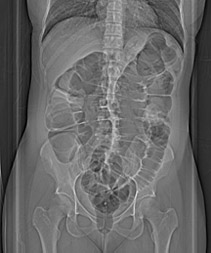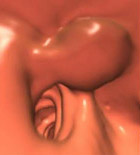CT colonography

CT colonography (also known as "virtual colonoscopy") is a newer, minimally invasive way to check your colon for polyps or tumors. Traditional colonoscopies involve first sedating the patient and then inserting a long flexible scope into the rectum and up into the colon. Pictures from the scope are reviewed by the doctor in real time. If suspicious areas are found, samples of the tissue can be taken for biopsy and removed at that time in most cases.
CT colonography, by contrast, allows the patient to be fully awake during the procedure, and only a small tube is inserted a couple of inches into the rectum. A CT scan is performed with the patient lying flat on their back first, and then again lying on their stomach.
How do I prepare for a CT colonography?
Preparation for a CT colonography is similar to that of a traditional colonoscopy. You will be given a 3-day prep composed of laxatives and contrast. The laxatives will help to clean out your colon and the contrast will help tag your remaining stool and liquid to better help the doctor identify polyps or tumors.
The day before your study, you will only be able to drink clear liquids. On the day of the exam wear loose, comfortable clothing, and remove any jewelry around the area being scanned.
What can I expect during a CT colonography?
On the day of the scan, you will be asked to lie down on your side on the CT table. A small tube will be inserted a few inches into the rectum. Carbon dioxide will be gently pumped through the tube to expand the colon. The process isn't painful, but it can cause a feeling of fullness in the bowel and mild cramping.
You will be asked to roll onto your right and left sides during the instillation of carbon dioxide to ensure adequate distention of all areas of your colon. You will then lie flat on the CT table, and at least two separate CT scans will be taken while you’re on your back and then your stomach, each taking about 10 seconds. The entire process will take approximately 15-30 minutes. Because no sedation occurs during CT colonography, you will be able to resume normal activity immediately following your scan.
Are CT colonographies safe?
Because they are minimally invasive and require no sedation, CT colonographies are considered very safe. Patients are exposed to radiation during the procedure, and that exposure is similar to having a CT scan of the abdomen.
There is a very small risk of developing cancer later in life as a result of exposure to radiation, but the benefit of diagnosing potential problems early significantly outweigh that risk.
There is also a very slight risk that perforation of the bowel could occur as a result of inflating the colon. However, this perforation rate is significantly lower than that of traditional colonoscopies.
Is a CT colonography right for me?
 At this time, insurance companies and Medicare typically cover CT colonographies when the patient a) requires constant anticoagulation medication or has other medical conditions that would make getting a traditional colonoscopy riskier; or b) has already undergone a traditional colonoscopy but the colon could not be seen in its entirety (often due to bowel blockage, etc.).
At this time, insurance companies and Medicare typically cover CT colonographies when the patient a) requires constant anticoagulation medication or has other medical conditions that would make getting a traditional colonoscopy riskier; or b) has already undergone a traditional colonoscopy but the colon could not be seen in its entirety (often due to bowel blockage, etc.).
For all other circumstances, insurance companies reimburse only on a case-by-case basis, so you would need to talk to your insurance provider about getting pre-approval. If polyps or other abnormalities are found during CT colonography, you may still be required to have a follow-up traditional colonoscopy to remove any polyps found and take samples for biopsy.
When will I get my CT colonography results?
After the scan is complete, the results will be sent to your referring physician within 2 days. Your physician will let you know if there are any significant findings. If such areas are found, a follow-up traditional colonoscopy may be ordered to remove polyps and take samples for biopsy.